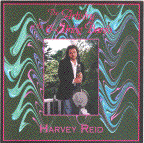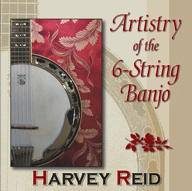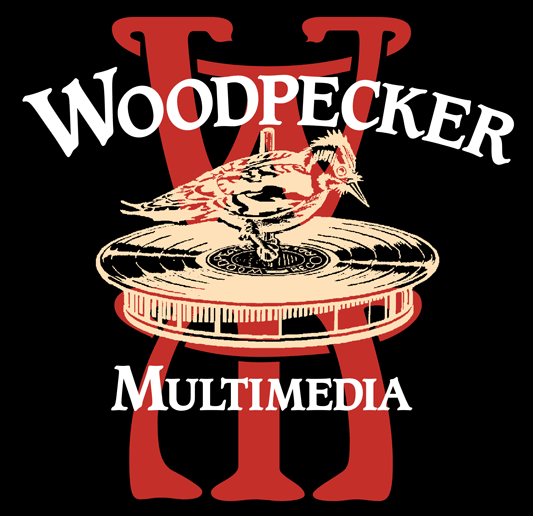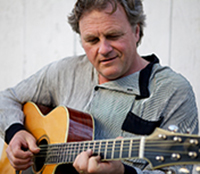|
|
 
Link to special
page of album release information. The art work was changed when the CD was remastered in 2009
The 6-string banjo, essentially a guitar neck on a banjo body,
has existed in a small corner of the music world for over a century,
never becoming either popular or totally obscure. The instrument
has been made sporadically by various manufacturers over the years,
and is one of many members of the banjo family; the 5-string being
the most common, followed by the 4-string (used in Dixieland and
Celtic music), plus a number of odd bass, baritone, ukelele and
mandolin-banjos.
Playing the 6-string banjo it is not simply a matter of playing
guitar music to get a different sound, since it responds very
differently than a guitar. It seems to frustrate both banjo players
and guitar players, who can't seem to make it sound like either
instrument. Though the 6-string is often ignored as a mutant hybrid,
I find it to be an alive, subtle, sensitive and expressive instrument
(as is the 12-string, which I use on 3 of the cuts [*]) with many
voices, capable of expressing the various moods of classical,
folk, old-time, bluegrass, celtic, ragtime, blues, and even rock
& roll music. I have been constantly surprised by what music
works well on it, and also by what doesn't.
I have never seen anyone really play one, and have had no signposts
or maps to guide me as I try to pry it open and play the music
that lurks beneath its innocent, hermaphrodite exterior. My success
stems from many years of playing fingerstyle guitar and traditional
music, from my invention of a partial capo on guitar for achieving
drone effects similar to the 5-string, and above all the re-design
of the instrument by the Deering Banjo Company, who make the extraordinary
instruments I play.This album marks the extent of my explorations
thus far. HR (July '95)
CREDITS
Harvey Reid 6-string & 12-string banjos, vocals
Guitar David Surette on Mock Orange, Sailor's Hornpipe
Moondi Klein on Jesse James
Dan Crary on Bill Bailey
Arrangements, Production, Engineering, Mixing Harvey Reid
Recording info No overdubs or multi-tracking of any sort were done. All
cuts recorded 1994-1995 at Woodpecker Towers, York, Maine in "living stereo",
direct-to-digital, using only Audio-Technica AT-4051 microphones, Mackie mixer
pre-amps and a Panasonic 3700 digital tape recorder except: #15,16,20=recorded
1990 at The Cottage near Bath, Maine, with Panasonic SV-255 DAT machine; #10=
recorded 2/89 at Juniper Studios, Burbank, CA
Digital Mastering Toby Mountain, Northeastern Digital, Southboro, MA.
Banjos Wide-neck 1988 Deering Maple-Blossom 6-string (MB-6), 1995 Deering
12-string (D-12)
Design, Type & Graphics Aphro-Graphics, Urchin Graphics,Glenn Reid,
Fractal Design
Cover Photo Kathleen Lloyd
Liner Notes Harvey Reid
(*) A partial capo was used on the banjo. Contact http://www.partialcapo.com
SPECIAL THANKS This album and the music on it owe their
existence almost entirely to Greg & Janet Deering and the
folks at Deering Banjos of Lemon Grove, California. I did not
feel myself filled with 6-string banjo music and go searching
for someone to make the instrument to express my dreams. I did
not find a tablet in the desert, nor was there any hint that the
world needed this music or any market or groundswell that I was
following. I simply found an instrument in my hands which opened
up the spigot and let the music come out. I had seen quite a few
other 6-string banjos, and dismissed them as uninteresting and
unresponsive. This instrument has continued to yield music and
surprises since 1988 when I began to play it, and the folks at
Deering have been constantly helpful and supportive. Thank you.
All selections © r 1988-1995 by Harvey Reid
(Quahog Music, BMI) except as noted. All rights reserved.
About the Music...
All the selections except Sittin' On Top Of The World were
done in standard guitar tuning, though in some cases the instrument
is tuned flat or sharp. Tracks 2,10,13 were released in 1994 on
an album called Chestnuts; 15 & 16 were released in 1990 on
Overview. Tracks (11,12,16,19) were recorded in 1989 on guitar
on #105 Solo Guitar Sketchbook; comparing the banjo and guitar
versions gives an interesting insight into the instrument. Fingerpicks
and the banjo's resonator were used unless specified. A partial
capo was used on several tracks (*), mostly Esus (capo 3,4,5 strings
at fret 2) or Open A (capo 2,3,4 at fret 2)
1- The Entertainer I have played this on guitar for almost
20 years, though it definitely sounds more musical on banjo than
guitar. The hardest part of playing it, of course, is to make
it sound easy, which unfortunately it is not. Capo 3, A position.
2- Jesse James A technique I invented that uses 3 fingerpicks
and no thumbpick, to imitate a 5-string banjo technique known
as frailing or clawhammer style. It's a totally different hand
motion, but gives the same sound. Capo 5 + Open A. (*) No resonator.
3- The Gaoler's Jig Written during the recording of this
album, while exploring the 12-string banjo. Near me is the oldest
jail (gaol they spelled it then) in colonial America, built in
1653. Tuned 1 step low, Esus capo. Flatpick, no resonator. (*)
4- Six-Shooter Stomp A sort of a cross between Jerry Lee
Lewis rhythms and Chuck Berry guitar riffs that emerged late one
night while I was drinking far too much coffee. Turns out the
6SB has properties a lot like an electric guitar. This one shoots
blanks on acoustic guitar. Capo 2, A position.
5- Minuet In G A standard piece for classical guitar students.
The 6SB can sound very sweet and baroque when you lighten up on
it. Capo 5.
6- Mock Orange No tunings, tricks or capos. Key of D &
a few 5-string banjo rolls and it sure sounds like one. Created
late one night in the studio from a groove and chord progression
of David's.
7- Sailor's Hornpipe I had to flatpick at least one old
fiddle tune, so here is one that almost every guitar flatpicker
learns but you seldom hear.
8- Sitting On Top Of The World A surprise that came late
one night (notice that I never say "early one morning...")
while wrestling with the 12-string banjo. A banjo is fundamentally
a drum, and has a very explosive sound as compared to a guitar.
It gives a very rocking feel, funkier than I can get on guitar,
along with the thump of my foot and some almost rim shot and brush
drum sounds from slapping the strings. No resonator. Open D tuning
with slide.
9-Rickett's Hornpipe/Boys From Bluehill I arranged these
tunes for guitar in 1983. They have a lilt and a lighter quality
on the banjo that is more musical and less athletic. (*) Capo
5 + Esus.
10- Bill Bailey That's guitar flatpicking legend Dan Crary
with me, in an unrehearsed & spirited jam in 1989. No capo,
key of C.
11-Andelusia Revisited This started out to be a remake
of For Whom The Bell Tolls, a tune on my guitar album, though
it went off in new directions. A lot of improvisation, and not
something I expected would work at all. Somehow it conveys the
mood of Spanish guitar. No capo. No resonator.
12- Suite: For The Duchess Written for guitar in 1982,
when I was trying to imitate a 5-string technique called chromatic
or melodic banjo, where successive scale notes are played on different
strings in a sort of harp-like manner. Capo 3 + Esus = G, the
original key it was written in. (*)
13- Old Black Joe If you get quiet, the banjo has a lot
of sustain, and an achingly sweet tone on slow melodies, especially
poignant in the high registers. Hard to do on stage, though. (*)
Capo 5 + Esus. Bare finger.
14- Good For Nothin' Blues Improvised in the studio. (Guess
what time of day...) The banjo does not have much sustain, so
to play a slow blues you have to approach it more like a New Orleans
style piano with triplets. Capo 2.
15- Chanoyu One of the most unusual things I ever came
up with- written & recorded at my dining room table one night
and never heard from before or since. Chanoyu is a Japanese tea
ceremony; somehow the banjo sounds like the koto, a Japanese lap
harp. Capo 2 + Esus at fret 6 (*)
16- Cindy/Cripple Creek Uses a partial capo and "mock
frailing" in Esus configuration, plus a straight capo at
the 7th fret. No resonator. (*)
17- Bonaparte Crossing The Rhine A lovely fiddle tune that
I usually play on bouzouki. It's quite tricky to split the octave
pairs of the 12-string to play only the bass notes, which have
an unearthly sound. No resonator. (*) Capo Esus.
18- Pieces Of Eight My first piece for the 6SB, intended
to imitate some of the kinds of things that 5-string players do-
with chromatic runs, open strings and rolls. Re-recorded; the
original version was 1988. Capo 5 + Esus. (*)
19- Canal Street Strut Written for guitar. The 6SB may
be the ultimate ragtime guitar. Makes a happier sound than the
guitar. No resonator, capo 2.
20- The Cuckoo Normally I don't like to do mock frailing
unless it's capoed up pretty high so the treble rings, but this
has a low end roar that I like. You need decent speakers to really
hear my foot. Recorded on Steel Drivin' Man in 1991. No resonator.
(*) Capo 3 + Esus.
21- The Unknown Soldier Written for the 6SB, and recorded
on guitar on #108 Circles because I was unable to get a good recording
of the banjo. Here it is, somewhat tardy. When played slowly and
close-miked, the banjo's tone is powerful and haunting, though
hard to control. Capo 5 + Open A (*)
©2017
|
 H
H



